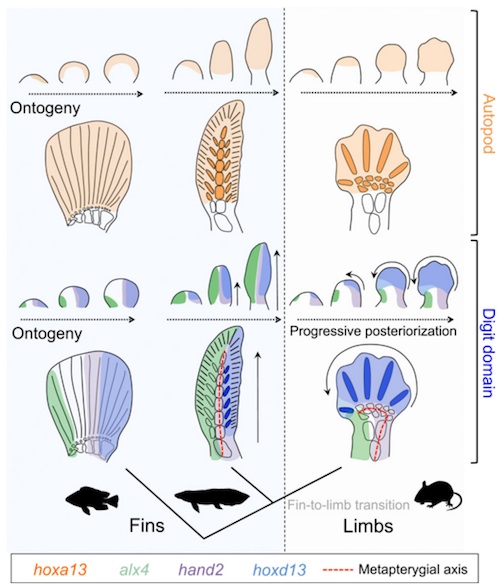|
|
Developmental Biology - Limb Evolution
From Fin to Limb
How our limbs and digits evolved from fish fins approximately 400 million years ago...
The Australian lungfish is the closest living fish relative of tetrapods and is often considered a "living fossil." It still resembles fish that lived when the first four-limbed vertebrates began to walk on land.
The fins of lungfish provide the best reference for the transition from fin to limb - better than any other existing fish species.
Approximately 400 million years ago in earth's Devonian Period, the "walking fin" transition allowed vertebrates to leave water and conquer land that was just beginning to team with plant life. This transition gave rise to all four-legged animals or tetrapods - an animal lineage that includes all amphibians, reptiles, birds and mammals.
Since the nineteenth century, several theories based on both fossil and embryo research, have tried to explain how tetrapod transformation unfolded. But, exactly how hands with digits originated from fish fins has remained unknown.
Now research reported in the latest issue of Science Advances, finds a primitive hand exists in lungfish fins even today!
The Limb "Architect" Genes
"During embryogenesis, a suite of 'architect' genes shape an amorphous group of cells into fully grown limbs."
Joost Woltering PhD, Assistant Professor, Evolutionary Biology, Axel Meyer Laboratory, University of Konstanz, Germany.
The very same "architect" genes also drive fin development. Evolutionary change in the activity of these genes, produces fins in fish and limbs in tetrapods. To understand the process creating fins and limbs, scientists studied "architect genes" in embryos of the Australian lungfish, as this domain has never been observed in fins of any other fish more distantly related to tetrapods.
"Amazingly, we discovered the gene specific to a hand on limbs (hoxa13) is activated in a similar skeletal region in lungfish fins. This finding indicates a primitive hand was already present in these ancestors of land animals."
Joost Woltering PhD.
Patterns & Similarities
In spite of this modern gene signature, the lungfish "hand" only partially resembles the tetrapod hand. It lacks fingers or toes - digits. To understand why, scientists looked for genes associated with digits and found only one hoxd13 "sister gene" to hoxa13.
During tetrapod limb development, the hoxd13 gene becomes activated in the developing pinky finger and then expands throughout the future hand towards the thumb, coordinating formation of all five fingers.
While Joost Woltering's team observed a similar gene activation pattern in lungfish fins, it did not find expansion as it only remained active in exactly half of the fin. Additional differences were found in lungfish fins. Genes normally switched off in digits remained active, but opposite to the domain of hoxd13.
Old Ideas - Future Directions
One hypothesis regarding the evolution of limbs first suggested in the early 20th-century by palaeontologists Thomas Westoll and William Gregory, and famously expanded upon in the 1980s by Neil Shubin, proposes fingers and toes arose from expansion of skeletal elements only on one side of the fins of our tetrapod ancestor.
This theory of fin expansion corresponds exactly to the differences found in digit expansion genes between lungfish fins and tetrapod limbs. Oservations on the activation and deactivation of limb "architect" genes in lungfish fins thus provides evidence in support of this classical transformational model.
In the future, to fully understand what causes this domain to expand and make our limbs so different from fish fins, researchers plan to conduct more analyses of fins and limb development in lungfish, also studying more modern fish species such as cichlids. Cichlid embryos are easier to investigate using techniques like CRISPR.
"All of this shows that while lungfish fins unexpectedly have a primitive hand in common with tetrapods - the fins of our ancestors also needed an evolutionary 'finishing touch'. It looks as if the hand was there first, to be complemented with digits later during evolution,"
Joost M. Woltering.
Abstract
How the hand and digits originated from fish fins during the Devonian fin-to-limb transition remains unsolved. Controversy in this conundrum stems from the scarcity of ontogenetic data from extant lobe-finned fishes. We report the patterning of an autopod-like domain by hoxa13 during fin development of the Australian lungfish, the most closely related extant fish relative of tetrapods. Differences from tetrapod limbs include the absence of digit-specific expansion of hoxd13 and hand2 and distal limitation of alx4 and pax9, which potentially evolved through an enhanced response to shh signaling in limbs. These developmental patterns indicate that the digit program originated in postaxial fin radials and later expanded anteriorly inside of a preexisting autopod-like domain during the evolution of limbs. Our findings provide a genetic framework for the transition of fins into limbs — that supports the significance of classical models proposing a bending of the tetrapod metapterygial axis.
Authors
Joost M. Woltering1, Iker Irisarri, Rolf Ericsson, Jean M. P. Joss, Paolo Sordino and Axel Meyer.
Acknowledgements
This is an open-access article distributed under the terms of the Creative Commons Attribution license, which permits unrestricted use, distribution, and reproduction in any medium, provided the original work is properly cited.
Return to top of page.
| |
|
Aug 28 2020 Fetal Timeline Maternal Timeline News
 Sarcopterygian fins (Australian lungfish fin shown) resemble tetrapod limbs, and proximally clear homologs of the humerus, radius, and ulna can be identified (pink field) (5, 8), an organization that is absent from ray finned fish (actinopterygians). In the distal region, they, however, lack the tetrapod-specific cross-articular anatomy (bend arrow) by which the long bones of the hand articulate with the radius and ulna via the nodular bones of the wrist (black). Hence, the evolutionary origin of the hand and digits at the fin-to-limb transition remains unresolved (yellow field). CREDIT Science Advances.
|



